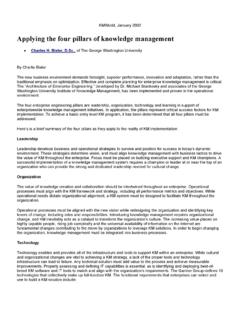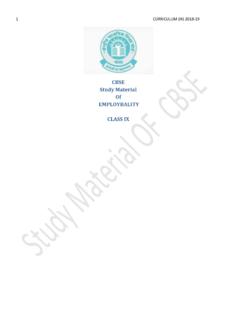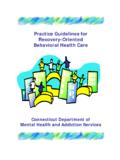Transcription of A LEARNING ORGANIZATIONA LEARNING ORGANIZATION
1 A LEARNING ORGANIZATIONA LEARNING ORGANIZATIONA LEARNING ORGANIZATIONA LEARNING ORGANIZATION In times of drastic change, it is the learners who inherit the future. The learned usually find themselves equipped to live in a world that no longer exists. (author unknown) It would seem obvious that an institution whose mission is effective teaching and LEARNING should automatically be a LEARNING ORGANIZATION . In our vision we declare ourselves to be a LEARNING ORGANIZATION so we must be one. But, are we really? Many colleges are not. This white paper provides background information on what is a LEARNING ORGANIZATION , discusses the 3 different issues of strategic conversations, instruction, and diversity in the context of a LEARNING ORGANIZATION , and introduces the concepts of new science and leadership, systems self- ORGANIZATION , and chaos and their effect in changing roles of individuals and the behavior of the ORGANIZATION .
2 The following questions are addressed: 1.) What is a LEARNING ORGANIZATION ? are the activities of a LEARNING ORGANIZATION ? b. Why build a LEARNING ORGANIZATION ? c. What are the 5 disciplines? d. What are the attributes of a LEARNING ORGANIZATION ? 2.) What are some examples of a LEARNING ORGANIZATION within Maricopa? a. How do strategic conversations contribute? b. How does the issue of diversity relate to a LEARNING ORGANIZATION ? c. Is there an instructional example? 3.) How does Maricopa self-organize itself and practice new leadership? a. What skill sets will individuals need to have? b. How do we identify ourselves as learners in a LEARNING ORGANIZATION ? 4.) How do we assess our ORGANIZATION as a LEARNING ORGANIZATION ? WHAT IS A LEARNING ORGANIZATION ? David Garvin in the August 1993 Harvard Business Review defines a leaning ORGANIZATION as "an ORGANIZATION skilled at creating, acquiring, and transferring knowledge, and at modifying its behavior to reflect new knowledge and insights.
3 " The important component of this definition is the requirement that change occur in the way work gets done. This test rules out a number of obvious candidates such as colleges. We in colleges have been successful in creating knowledge (research) and transferring knowledge (teaching) but have not been successful in applying that knowledge to our own activities. Peter Senge in his book, The Fifth Discipline, described a LEARNING ORGANIZATION as "a place where people continually expand their capacity to create results they truly desire, where new and expansive patterns of thinking are nurtured, where collective aspiration is set free and where people are continually LEARNING how to learn." This definition is very idyllic and abstract. Its focus is on philosophical grand scheme. It is very desirable but what we must do to get there is unanswered.
4 Ross, Smith, Roberts and Kleiner advocate this definition. " LEARNING in an ORGANIZATION means the continuous testing of experience, and the transformation of that experience into knowledge- accessible to the whole ORGANIZATION , and relevant to its core purpose." These authors suggest a checklist from this definition. 1. Are you willing to examine and challenge your sacred cows? 2. What kinds of structures have you designed for this testing? 3. When people raise potentially negative information, do you shoot the messenger? 4. Does your ORGANIZATION show capabilities it didn't have before? 5. Do you feel as if what you know is qualitatively different - "value-added" from the data you took in? 6. Is the knowledge accessible to all of the ORGANIZATION 's members? (Ross, Smith, Roberts, Kleiner, The Fifth Discipline Fieldbook, p 49.)
5 ACTIVITIES OF A LEARNING ACTIVITIES OF A LEARNING ACTIVITIES OF A LEARNING ACTIVITIES OF A LEARNING ORGANIZATION 1. Systematic problem solving: thinking with systems theory; insisting on data rather than assumptions; using statistical tools 2. Experimentation with new approaches: ensure steady flow of new ideas; incentives for risk taking; demonstration projects 3. LEARNING from their own experiences and past history: recognition of the value of productive failure instead of unproductive success 4. LEARNING from the experiences and best practices of others: enthusiastic borrowing 5. Transferring knowledge quickly and efficiently throughout the ORGANIZATION : reports, tours, personnel rotation programs, training programs (David Garvin, "Building a LEARNING ORGANIZATION ", Harvard Business Review, Aug.)
6 1993, pp. 78-90.) REASONS TO BUILD A LEARNING REASONS TO BUILD A LEARNING REASONS TO BUILD A LEARNING REASONS TO BUILD A LEARNING ORGANIZATION 1. Because we want superior performance 2. To improve quality 3. For customers 4. For competitive advantage 5. For an energized, committed workforce 6. To manage change 7. For the truth 8. Because the times demand it 9. Because we recognize our interdependence 10. Because we want it (The Fifth Discipline Fieldbook, p 9-12) THE FIVE THE FIVE THE FIVE THE FIVE DISCIPLINES "The core of LEARNING ORGANIZATION work is based upon five " LEARNING disciplines" - lifelong programs of study and practice: 1. Personal masteryPersonal masteryPersonal masteryPersonal mastery- LEARNING to expand our personal capacity to create results we most desire and creating an organizational environment which encourages all its members to develop themselves toward goals and purposes they choose.
7 2. Mental ModelsMental ModelsMental ModelsMental Models- reflecting upon, continually clarifying, and improving our internal pictures of the world, and seeing how they shape our actions and decisions. 3. Shared VisionShared VisionShared VisionShared Vision- building a sense of commitment in a group, be developing shared images of the future we seek to create, and the principles and guiding practices by which we hope to get there. 4. Team LearningTeam LearningTeam LearningTeam LEARNING - transforming conversational and collective thinking skills, so that groups of people can reliably develop intelligence and ability greater than the sum of individual members' talents. 5. Systems ThinkingSystems ThinkingSystems ThinkingSystems Thinking- a way of thinking about, and a language for describing and understanding forces and interrelationships that shape the behavior of systems.
8 This discipline helps us see how to change systems more effectively, and to act more in tune with the larger processes of the natural and economic world. (Peter Senge, The Fifth Discipline Fieldbook, pp. 6-7) ATTRIBUTES OF A LEARNING ATTRIBUTES OF A LEARNING ATTRIBUTES OF A LEARNING ATTRIBUTES OF A LEARNING ORGANIZATION William O'Brien, former CEO of the Hanover Insurance Company describes 4 attributes that are necessary to cope with change. "The first is LEARNING how to disperse power disperse power disperse power disperse power on an orderly, non chaotic basis. Right now the word "empowerment" is a very powerful buzzword. It's also very dangerous. Just granting power, with out some method of discipline and order that comes out of a command-and-control bureaucracy, produces chaos. We have to learn to disperse power so self-discipline can largely replace imposed discipline.
9 That immerses us in the area of culture; replacing the bureaucracy with aspirations, values, and visions. The second attribute of winning companies will be systemic are good at the type of problem which lend itself to a scientific solution and reductionistic thinking. We are absolutely illiterate in subjects that require us to understand systems and interrelationships. 3. 3. 3. 3. The third attribute that twenty-first companies will need is conversationconversationconversationconv ersation. This is the single greatest tool in your ORGANIZATION - more important than computers or sophisticated research. We are good at small when we face contentious issues-- when there are feelings about rights, or when two worthwhile principles come into conflict with one another -- we have so many defense mechanisms that impede communications that we are absolutely terrible.
10 4. 4. 4. 4. Finally, under our old system of governance, one could lead by mandate. If you had the ability to climb the ladder, gain power, and then control that power, you could enforce these changes in attributes. But the forthcoming kind of company is going to require voluntary followershipvoluntary followershipvoluntary followershipvoluntary followership. Most of our leaders don't think in terms of getting voluntary followers; they think in terms of control." (William O'Brien, The Fifth Discipline Fieldbook, pp. 13-14.) EXAMPLES WITHIN MARICOPA COMMUNITY COLLEGES: THE ROLE OF "STRATEGIC CONVERSATIONS" THE ROLE OF "STRATEGIC CONVERSATIONS" THE ROLE OF "STRATEGIC CONVERSATIONS" THE ROLE OF "STRATEGIC CONVERSATIONS" Organizations learn. Just like individual people, organizations sensesensesensesense circumstances within their environment and they respondrespondrespondrespond.









